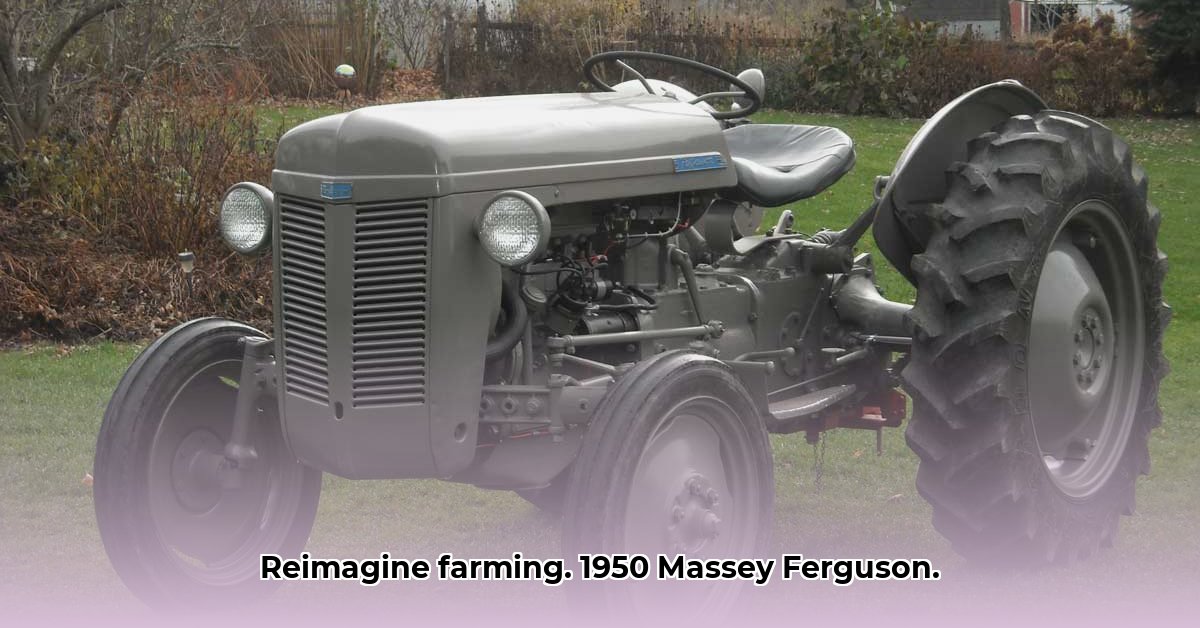
The roar of a tractor engine, the smell of freshly turned earth – these are the sensory hallmarks of post-World War II agriculture. Farmers, facing unprecedented demands for food production, desperately needed efficient machinery. Enter the 1950 Massey Ferguson 50 tractor, a pivotal machine that redefined agricultural efficiency. This article examines the MF 50's design, comparing it to its celebrated predecessor, the Ferguson TO-20, and exploring its lasting impact on farming practices. We'll delve into the technical details, revealing how this tractor helped shape modern, sustainable agriculture. For another example of innovative design, check out this Ford 9N tractor.
From Plow to Powerhouse: The Post-War Agricultural Boom
The years immediately following World War II witnessed an unprecedented surge in global food demand. Traditional farming methods, often reliant on manual labor, proved inadequate. Mechanization became crucial, and the tractor emerged as a symbol of this agricultural revolution. The 1950 Massey Ferguson 50, with its innovative features, became a critical player in this transformation, fundamentally altering farming practices across the globe. Did you know that the widespread adoption of tractors like the MF 50 significantly increased per-farm yield, contributing to global food security?
A Tale of Two Tractors: TO-20 vs. MF 50
The Ferguson TO-20, a highly successful tractor, served as a benchmark for its time. Its simplicity, reliability, and use of readily available gasoline engines made it a popular choice for many farmers. However, its four-speed transmission and limited power output began to show their limitations in the face of increasing needs.
The Massey Ferguson 50 emerged as a significant improvement, offering farmers choices. Unlike its predecessor's gasoline-only engine, the MF 50 offered gasoline, diesel, and even liquid petroleum gas (LPG) options. This adaptability proved crucial, ensuring farmers flexibility in fuel choices based on cost and availability. The transmission also saw a major upgrade, offering models with 6-forward/2-reverse or a more advanced 12-forward/4-reverse power shift, significantly increasing efficiency and versatility. While both tractors featured open operator stations, reflecting the era's priorities, the MF 50 offered an optional power steering upgrade – a testament to evolving design considerations and farmer needs. But how did these mechanical improvements translate to real-world performance?
Under the Hood: A Technical Comparison
While precise figures for horsepower and fuel consumption vary due to limitations in historical records, the MF 50's heavier build (1500-1655 kg versus the TO-20's 1251 kg) suggests improved stability, especially when working with heavy loads. The availability of various engine types not only offered greater flexibility but likely contributed to better fuel economy, depending on the engine choice, compared to the gasoline-only TO-20. The shift towards diesel engines, for instance, typically offered improved fuel efficiency. This fact demonstrates the MF 50's forward-thinking design, foreshadowing modern discussions on fuel diversification and sustainable agriculture. It's a testament to the ingenuity of its designers to anticipate these advancements decades ahead.
The MF 50's Enduring Legacy: A Revolution in Efficiency and Sustainability
The enduring popularity of the 1950 Massey Ferguson 50 speaks volumes. Its reliability, versatility, and improved fuel economy significantly impacted farming practices. While not an immediate, transformative shift, the MF 50's gradual incorporation into agriculture laid the groundwork for greater efficiency and sustainability. Its contributions to modern farming practices continue to resonate even today, showing the remarkable impact of careful design and innovation. Think about the ripple effects – greater efficiency means less fuel consumption and reduced environmental impact – a concept highly relevant in today's world.
Continuing the Conversation: Areas for Future Research
Despite its historical significance, some aspects of the MF 50's performance remain unquantified. Further research is needed to pinpoint the exact fuel efficiency gains compared to the TO-20 and to fully characterize the power take-off (PTO) capabilities of both machines. This detailed analysis would provide a comprehensive understanding of the MF 50's efficiency in various farming operations. Such research would not only be valuable for historians but also for enthusiasts seeking to restore and maintain these vintage tractors.
A Quick Comparison: Key Features
| Feature | Ferguson TO-20 | 1950 Massey Ferguson 50 |
|---|---|---|
| Engine Type | Gasoline | Gasoline, Diesel, LPG |
| Transmission | 4-speed Constant Mesh | 6 forward/2 reverse or 12 forward/4 reverse (power shift) |
| Weight (kg) | 1251 | 1500-1655 |
| Power Steering | No | Optional |
This summary highlights key differences; a more comprehensive analysis would demand more detailed historical data and further research.